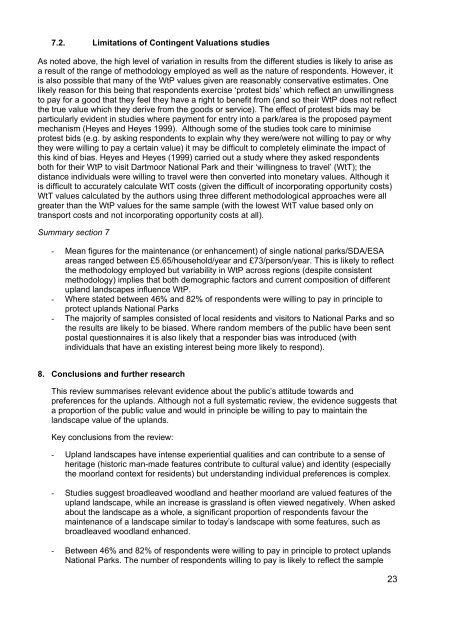Public Attitudes and Preferences for Upland Landscapes - Defra
Public Attitudes and Preferences for Upland Landscapes - Defra
Public Attitudes and Preferences for Upland Landscapes - Defra
Create successful ePaper yourself
Turn your PDF publications into a flip-book with our unique Google optimized e-Paper software.
7.2. Limitations of Contingent Valuations studies<br />
As noted above, the high level of variation in results from the different studies is likely to arise as<br />
a result of the range of methodology employed as well as the nature of respondents. However, it<br />
is also possible that many of the WtP values given are reasonably conservative estimates. One<br />
likely reason <strong>for</strong> this being that respondents exercise ‘protest bids’ which reflect an unwillingness<br />
to pay <strong>for</strong> a good that they feel they have a right to benefit from (<strong>and</strong> so their WtP does not reflect<br />
the true value which they derive from the goods or service). The effect of protest bids may be<br />
particularly evident in studies where payment <strong>for</strong> entry into a park/area is the proposed payment<br />
mechanism (Heyes <strong>and</strong> Heyes 1999). Although some of the studies took care to minimise<br />
protest bids (e.g. by asking respondents to explain why they were/were not willing to pay or why<br />
they were willing to pay a certain value) it may be difficult to completely eliminate the impact of<br />
this kind of bias. Heyes <strong>and</strong> Heyes (1999) carried out a study where they asked respondents<br />
both <strong>for</strong> their WtP to visit Dartmoor National Park <strong>and</strong> their ‘willingness to travel’ (WtT); the<br />
distance individuals were willing to travel were then converted into monetary values. Although it<br />
is difficult to accurately calculate WtT costs (given the difficult of incorporating opportunity costs)<br />
WtT values calculated by the authors using three different methodological approaches were all<br />
greater than the WtP values <strong>for</strong> the same sample (with the lowest WtT value based only on<br />
transport costs <strong>and</strong> not incorporating opportunity costs at all).<br />
Summary section 7<br />
- Mean figures <strong>for</strong> the maintenance (or enhancement) of single national parks/SDA/ESA<br />
areas ranged between £5.65/household/year <strong>and</strong> £73/person/year. This is likely to reflect<br />
the methodology employed but variability in WtP across regions (despite consistent<br />
methodology) implies that both demographic factors <strong>and</strong> current composition of different<br />
upl<strong>and</strong> l<strong>and</strong>scapes influence WtP.<br />
- Where stated between 46% <strong>and</strong> 82% of respondents were willing to pay in principle to<br />
protect upl<strong>and</strong>s National Parks<br />
- The majority of samples consisted of local residents <strong>and</strong> visitors to National Parks <strong>and</strong> so<br />
the results are likely to be biased. Where r<strong>and</strong>om members of the public have been sent<br />
postal questionnaires it is also likely that a responder bias was introduced (with<br />
individuals that have an existing interest being more likely to respond).<br />
8. Conclusions <strong>and</strong> further research<br />
This review summarises relevant evidence about the public’s attitude towards <strong>and</strong><br />
preferences <strong>for</strong> the upl<strong>and</strong>s. Although not a full systematic review, the evidence suggests that<br />
a proportion of the public value <strong>and</strong> would in principle be willing to pay to maintain the<br />
l<strong>and</strong>scape value of the upl<strong>and</strong>s.<br />
Key conclusions from the review:<br />
- Upl<strong>and</strong> l<strong>and</strong>scapes have intense experiential qualities <strong>and</strong> can contribute to a sense of<br />
heritage (historic man-made features contribute to cultural value) <strong>and</strong> identity (especially<br />
the moorl<strong>and</strong> context <strong>for</strong> residents) but underst<strong>and</strong>ing individual preferences is complex.<br />
- Studies suggest broadleaved woodl<strong>and</strong> <strong>and</strong> heather moorl<strong>and</strong> are valued features of the<br />
upl<strong>and</strong> l<strong>and</strong>scape, while an increase is grassl<strong>and</strong> is often viewed negatively. When asked<br />
about the l<strong>and</strong>scape as a whole, a significant proportion of respondents favour the<br />
maintenance of a l<strong>and</strong>scape similar to today’s l<strong>and</strong>scape with some features, such as<br />
broadleaved woodl<strong>and</strong> enhanced.<br />
- Between 46% <strong>and</strong> 82% of respondents were willing to pay in principle to protect upl<strong>and</strong>s<br />
National Parks. The number of respondents willing to pay is likely to reflect the sample<br />
23
















